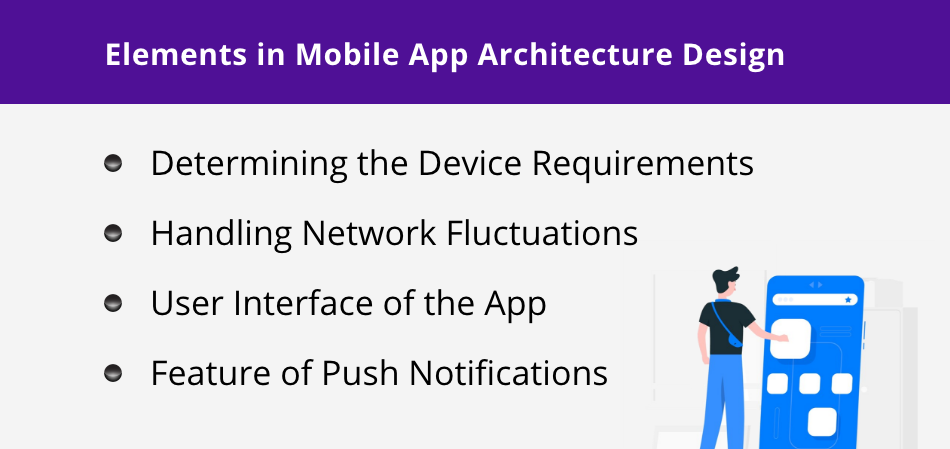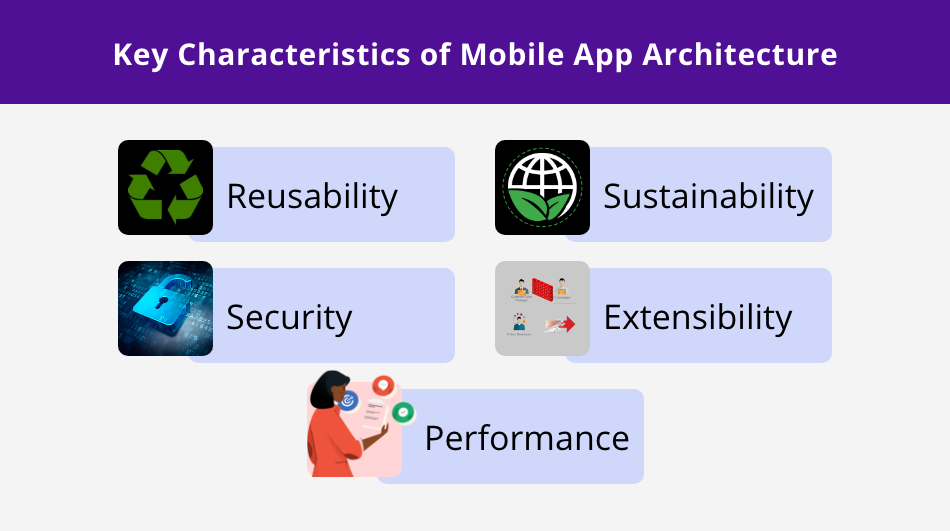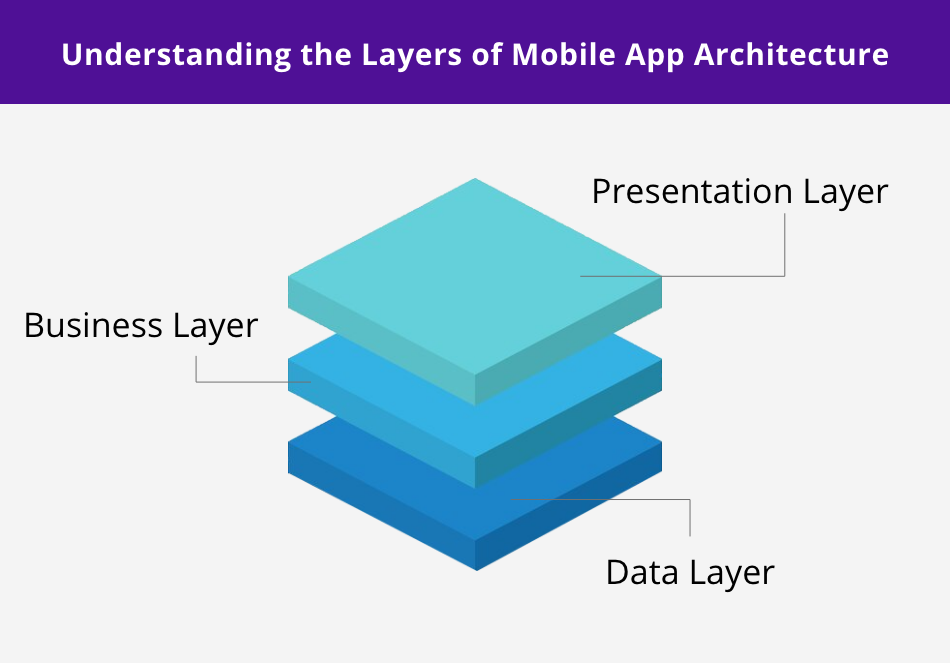Mobile app architecture is a combination of models, designs, and techniques that are used to build an app ecosystem.
Updated 22 March 2024

Global Delivery Head at Appventurez
Mobile apps have become a significant aspect of any business that is looking to expand its operations and user base in the market. However, before developing a mobile app that enhances user experience and accelerates revenue growth, it is significant to understand the mobile app architecture.
Mobile app architecture is a blueprint for a mobile application’s design, further encompassing the organization of code and the decision-making framework that further guides the mobile app development services. App architecture is also critical as it affects not only the app’s performance but also its maintainability and user experience in the ever-changing technological landscape.
In this blog, we will further explore the role of mobile app architecture in the app development process. We will also discuss-
It refers to a framework in which an app is structured and organized. The process includes the app’s overall design, the way its code is organized, and the specific tools and frameworks that will be used while developing the mobile app.
When it comes to formulating an app that embraces architectural patterns for mobile applications, it is important to reflect on many functionalities that can substantiate the answer to building a vital app such as features, screen size, navigation panel, etc.
The demand for mobile apps is rising by leaps and bounds every year. As per the report, mobile apps are projected to generate more than 613 US dollars in revenues in 2025.
A well-designed mobile architecture can help improve the overall performance, scalability, and stability of the app while also making it easier to develop and maintain an app over time. Read more about the significance of mobile app architecture in the points below:
If you are looking for a mobile app that is compatible with different devices and mobile platforms, choosing the right architecture is vital. Different architectures of mobile apps provide different levels of compatibility with diverse systems.
Compatibility through mobile application architecture refers to a mobile app’s ability to share and receive data from other systems or perform the intended functions without any restrictions to the user interface.
The speed and quality of the mobile app strongly rely on the underlying architecture of the mobile app. Undoubtedly, architecture defines how different components interact and behave to make the whole app functional.
An efficient mobile app architecture yields a superior user experience by providing quick app response. Hence, it is important to pay attention to the architecture design and follow an advanced mobile app development strategy to create a winning application.
Mobile architecture design is significant in making the app scalable and adaptive to incorporate futuristic features that will give it an edge in the market. Well-defined mobile applications architecture makes it easy to integrate additional features and modify the app as per the requirements.
In addition, as the business grows, there is an increasing number of users and workload that your app can handle with no impact on performance and reliability. A scalable application is crucial for an ever-expanding user base.
It is important to create a robust mobile app architecture for the app that can stand the test of time. However, before creating the app, it is important to understand what different factors impact the development of app architecture.

The mobile apps, throughout their lifecycle, will encounter situations where the internet connectivity is weak or fully unavailable. Hence, your app must be ready to handle the worst network conditions, and is crucial to create an app architecture that is capable of dealing with any state of network connection.
To build a solid architecture for your mobile application, you should consider the device and hardware specifications that you wish to target. Since the applications depend on the device features and the hardware for its functioning, it is crucial to get the details of the devices it would run on.
The importance of mobile UI design services cannot be overstated in app development as it should be designed to keep the users engaged with your application and provide a seamless experience. When it comes to creating a mobile app architecture diagram, it is important to include the aspects of UI/UX to craft an app that resonates with your audience.
While formulating the mobile app information architecture, it is important to identify if your users require real-time updates or notifications. It is made up of different layers that stack together to form the whole ecosystem. Facilitating push notifications helps businesses engage the target audience and provide them the updates as per their preferences.
A mobile app architecture needs to be flexible, extensible, and possess other qualities for a stable and robust mobile application. Some of the key attributes of a mobile architecture are:

The architecture should be able to sustain technological changes or shifts in market demand. Hence, the mobile app needs to be ready to adjust according to these changes. It calls for a mobile development architecture design that is resilient to these changes and a sustainable mobile app that is capable of handling changes like improved technologies and servers.
With reusability, you can deploy and develop the application features at a faster speed. An efficient mobile app architecture is built with code reusability in mind and allows the developers to quickly build and release the different updates and versions of the application.
In the current times, security has become so significant that big businesses spend millions to enhance their security services. While developing a mobile app, it is important to consider an application architecture that provides a high level of security and also ensures compliance with various standards.
The continuous changes in user needs require you to integrate more functionality over time and if your app is built on a flexible architecture, it will be easy to implement new features. Hence, dividing the app components to form a loosely coupled architecture will further simplify the integration of the features.
The mobile app developers aim is to prioritize the user experience and functionality when it comes to app development. The users expect that the applications, whether Android or iOS should respond to their taps instantly and execute the tasks. Hence, it is important to choose an architecture that offers excellent performance.
While we understand the significance and role of mobile application architecture in app development, it is also important to comprehend the different layers of the app architecture that communicate with each other and pass on the data to trigger various functionalities. The following are the common layers for most mobile apps:

The presentation layer sits on top of a mobile application architecture stack and defines how an application will be presented to the end users. It is a user interface and communication layer where the users interact with the application. Simply put, the presentation layer handles the user interactions and represents the face of a mobile app where the users can find all kinds of GUI elements.
This particular layer is related to the business logic for the application as it provides a set of rules and algorithms that manage the flow of data in the context of the business.
The role of the business layer in the mobile app architecture is to define how the data will be generated, processed, stored, and used for a mobile application. Depending on the operations of a mobile app, the business layer can exist on a device or on a server.
Mobile applications must have a secure and efficient mechanism for data transactions. This responsibility is managed by the data layer which ensures the transfer and receipt of data seamlessly.
The data layer also consists of various components such as data access components, service agents, data utilities, etc. to further enable the data transactions with an app. When it comes to designing a data layer, you need to consider the ease of modification as per the change in requirements and maintenance.
From performance to scalability, all the significant features of the mobile app depend on its architecture. Therefore, it is important to choose the right architecture that not only meets your requirements but also facilitates excellent performance. Follow the below-mentioned best practices for a good mobile application architecture diagram.
Under mobile app architecture designs, there are different patterns for various platforms and operating systems. Your mobile app architecture can vary based on the type of users or the platforms that you wish to target, For instance, there is a difference between the iOS architecture patterns and the Android architecture pattern.
A typical Android app is composed of multiple app components. The app also requires a manifest file where all these components are declared. On the other hand, iOS apps reside in the IPA container where all the app data is compressed and packed.
Let’s further understand the points below:
Swift and Objective-C are the two languages to develop native iOS applications. While there are no specific guidelines for Android apps, Apple guides through the app development where the apps use an architecture with an MVC pattern. Although iOS developers can choose any architecture, it is the most common pattern to follow for iOS application development services.
MVC is a three-tier architecture for mobile applications. Here are the different layers it has:
The layer manages the data, rules, and logic of an application and consists of the model projects, networking code, etc.
It is the presentation layer for MVC architecture as there are elements for user interaction and it doesn’t have any business logic.
This layer is responsible for establishing communication between the two other layers- model and view.
Mobile app architecture best practices can only be fulfilled if things are carried on in the right manner. Whether it is about mobile or web app architecture, there are a few sets of guidelines that have already been dispensed by the majority of developers promising a constructive app for businesses.
There is a set of practices to follow for Android app development solutions that conform to the mobile architecture design for building productive and quality apps. To decide what would be best for Android app development, it is important to pay heed to Android frameworks, libraries, and app-developing concepts mentioned in the developer’s guide.
However, the most common Android architecture in enterprise mobile application development is the clean architecture. The clean architecture is based on the layers and the inversion of the core principles and is composed of business, presentation, and data layers.
The benefits of Clean Architecture are:
These mobile apps are a hybrid of native and web applications. These apps have native mobile app architecture in which the web-based content is loaded. While also understanding the difference between native and hybrid app, it is important to note that hybrid mobile apps use a single codebase for different mobile platforms, so a single hybrid app will function on different platforms whether Android or iOS.
Hybrid app architecture has several advantages such as:
Another popular mobile app development architecture is cross-platform apps. Just like the hybrid apps, there is a single codebase for various platforms, and they are compatible with both Android and iOS, however, they are built on frameworks.
There are different cross-platform app development frameworks and technologies such as Ionic, Flutter, React Native, Xamarin, etc. In comparison to hybrid apps, these apps offer an experience that is much closer to the native apps and better in performance. Cross platform app development services offer benefits such as:
Choosing the best mobile app architecture is crucial to developing custom mobile apps with great performance, scalability, and security. Paying attention to your business requirements and users’ feedback can help you plan what features to include in the app, how to include them, and how these features will be connected through layers.
Appventurez, one of the leading mobile app development companies, specializes in crafting mobile app architecture that demands meticulous planning and a profound comprehension of app development practices.
While formulating an app architecture for mobile-friendly solutions, our skilled developers will help you determine the patterns and techniques that qualify as best practices in mobile app architecture.
Q. What is the best architecture for mobile applications?
MVC is the most preferred architecture for mobile applications. The mobile apps with MVC architecture are more extensible. React native, flutter, and Ionic are some of the well-known frameworks for building iOS apps as well as Android apps.
Q. What is the meaning of mobile app architecture?
The mobile application architecture is made up of different layers that stack together to form the whole app ecosystem. Dividing the app architecture into layers offers numerous benefits including scalability, reusability, flexibility, and maintenance.
Q. What are the three main layers of mobile app architecture?
Mobile app architecture can incorporate several layers, but it consists of three layers in most cases. The three layers are the presentation layer, the data layer, and the business layer.
Q. Why the mobile app is important?
Mobile app architecture is the foundation upon which all successful mobile apps are built, further determining their functionality, scalability, and overall quality. By prioritizing the architecture, you can ensure that mobile apps are well-equipped to thrive in the competitive and ever-evolving mobile marketplace.
Q. What is an architecture diagram?
An architecture diagram is a visual representation of all the elements that make up part, or all, of a system. Above all, it also helps the engineers, designers, stakeholders, or anyone else involved in the project to understand a system or app’s layout.


Elevate your journey and empower your choices with our insightful guidance.

Global Delivery Head at Appventurez
Ashish governs the process of software delivery operations. He ensures the end product attains the highest remarks in qualitative analysis and is streamlined to the clientele’s objectives. He has over a decade of experience as an iOS developer and teams mentorship.
You’re just one step away from turning your idea into a global product.
Everything begins with a simple conversation.